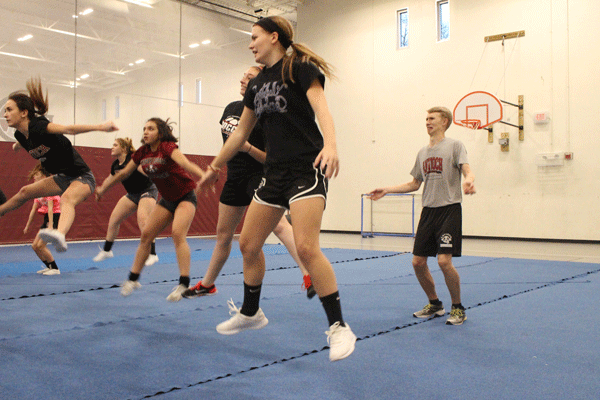TOM TOM TRIES: JV Cheerleading
See what happens when five Tom Tommers leave the newsroom and take to the mats.

Jack Connelly
It seems that anyone with cheerleading experience will tell you that it is incredibly difficult, while most others find them hard to believe. After two hours of trying cheer, I can assure you that the cheerleaders know what they are talking about.
Cheer is difficult. Like, really difficult.
It took me all of five seconds in the auxiliary gym for me to realize that I’m not cut out for cheer, and for one reason: flexibility. My definition of touching my toes was bracing for the pain and bouncing to grab my toes; theirs was placing their hands flat on the floor. My pride was only further injured once they began warming up for tumbling. I’m no expert, but tumbling appears to be a series of flips and jumps and other things designed to make people say “wow.” The extent of my tumbling experience (if it can be called that) came in the form of briefly attempting a handstand before falling onto my face.
After the ladies taught me that I was incompetent in the basics of their sport, they tried to teach me choreography. My dancing skills have never been good, but this showed me a whole new world: constant reminders to “keep it tight” (code for tensing every muscle in your body) and to “hit” everything (code for being in time with the cheer we were screaming). I never got close to understanding a basic routine that was a handful of seconds long, and they perform for minutes on end. The dedication and skill it takes to learn and perfect cheer routines is beyond both my comprehension and my patience, and we put that to the test in the final minutes of our time there. We did a small sample of a routine, and, while I was entirely lost, I was amazed at being immersed in the organized chaos that makes watching a cheer team compete so mesmerizing. The combination of flying, flipping, dancing and yelling make the sport awesome to watch, and I was beyond surprised by how much it takes to be a cheerleader.
Rebekah Cartlidge
When I found out that I would be going to cheerleading practice, I automatically got excited, but after giving it some more thought about what actually happens at a typical cheerleading practice, the nerves kicked in. I’ve been an athlete my entire life; I catch onto most sports quickly, but cheerleading was a different story.
The team was already stretching as I walked into the gym; leave it to me to be late to my first cheerleading practice. I got in line and quickly realized they were doing similar stretches to what I do during soccer and field hockey. I thought to myself maybe this won’t be too bad and that I might actually be decent. I was so wrong; during the circle stretches I couldn’t even touch my toes, and then they went into the splits, and the remaining shred of confidence I had left was gone.
Next, we had to learn the actual cheer, and we were very limited on time. I had to learn a dance and vocals to go with them in about an hour. Once again, I thought maybe there was a small chance I would be good at this. During marching band I could play my instrument and find multiple spots on the field with no problem. Learning drill in marching band is nothing like learning a cheer routine, and I have never been so confused in my entire life. Everything was so fast. I would get lost about two beats in and never be able to catch up, so I just ended up standing behind a stunt group so no one would see me.
Cheerleading was physically and mentally challenging. Going from being a goalie in field hockey to a base in a stunt group was a big and difficult change. I have a new respect for cheerleaders and all the work they put into every little move that they do.
Gabrielle Kalisz
From the time I could walk, I was uncoordinated. I tried to shove this blatantly obvious piece of information out of my head for as long as I could; I played basketball, softball and danced. Each and every time I tried a new sport, I came to the same conclusion: I am uncoordinated. Cheer was no exception.
“I don’t belong here” popped into my head. “Gabi what are you doing? You can barely walk in a staight line. Oh my, how did she move her body like that? Help me.”
I want to clarify that when I say cheer, it means both words and movements; this may not sound hard, but learn from my mistakes and just accept that it is. Every time I thought I had the moves down, I was reminded to be louder in my cheering; that’s when any hope of having the moves down went out the window. After about 20 minutes and some false confidence that I could maybe actually do it, we went “competition pace.” I am convinced that “competition pace” is a synonym for “way too fast.”
“Gabi you’re going to be the flyer.”
I nodded my head while shaking it while everyone else wasn’t looking. I trust Gracie and Bekah, but the idea of not being firmly planted on the ground quickly turned into fear. Against my better judgement, I took a deep breath and heeded the words of coach Weida: “squeeze the muscles and hope.” After feeling like I was going to die and almost falling on my butt, we got it down. It felt easier each time we tried, until they told us to do an extension. I have never felt my muscles in my body tense up that much. They slowly raised me above their heads and it ended successfully, but not without shrieks and a lot of fear.
Cheer was just another reminder that I am not coordinated at all. I can try and try all I want but in the end I wasn’t made out to be a cheerleader.
Grace Bouker
There’s always been the debate regarding whether or not cheerleading is a sport, and I’ve always shied away from the topic because I never really knew anything about it. Boy, was I about to find out.
As a soccer player, I didn’t really know what to expect from a cheerleading practice. We started with a dynamic warm up, which went well, and then proceeded to stretch. I have always known that I’m less than flexible, but this was a whole new level! The cheerleaders had their palms touching the ground, while I couldn’t even touch my toes. After that, we did tumbling, which wasn’t so bad because I was able to do a cartwheel and handstand without breaking something. But then, it got really hard.
We proceeded to learn a routine. This was probably the most challenging part, which was ironic because before practice, I thought that this would for sure be the easiest part. Turns out, memorizing motions and words to a cheer and performing them in perfect time is extremely frustrating. Plus, we were supposed to be loud, and “speaking from the diaphragm” isn’t my strong suit. It was really, really hard, and memorizing new dances and cheers in short periods of time is something I definitely have more respect for now.
Something I certainly wasn’t expecting was stunting. I ended up basing with Bekah while Jack and Kyle spotted Gabi, who was flying. I’m not a very balanced person, so holding someone above my head not only required strength and help from my friends, but it required a lot of concentration. Not to mention, I was sore for the next four days! I don’t use my arms in soccer for anything other than throw-ins, and squatting to hold girls up made my legs sore too, which shouldn’t have surprised me, but it did. I had to use a whole new set of muscles and it was taxing, but getting Gabi and the other girls up in the air without dropping them (except for once) was gratifying.
All in all, it is safe to say that cheerleading is definitely a sport, and a challenging one at that.





Aubrea • Aug 8, 2019 at 9:04 pm
I am uncordinated,tall and I have no rythm.I have always loved watching cheer.My favorite parts to see are flyers and the toe touches.Cheer is coming up soon at my highschool.I am willing to break my legs in order to have my dream.To be a flyer.I remember watching the girls be lifted up into the air and then land gracefully.I dont want to give up.My dream will happen.If anyone has anyway to help please tell me